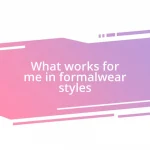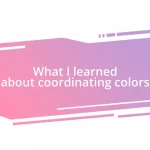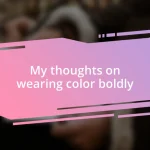Key takeaways:
- Understanding fabric types involves recognizing their unique qualities and how they can evoke memories or enhance comfort and style.
- Evaluating fabric quality is essential; factors like weight, finish, stretch, transparency, and pilling all contribute to comfort and durability.
- Selecting sustainable fabrics benefits both personal style and the environment, focusing on quality that lasts and responsible sourcing.
![]()
Understanding fabric types
When diving into the world of fabric types, it feels a bit like exploring a treasure chest. Each fabric has its own story – take silk, for instance. The way it drapes can add a luxurious flair to an outfit, making me feel elegant every time I wear it.
On the other hand, there’s cotton, which brings a sense of comfort and familiarity. I remember my favorite oversized cotton shirt from my college days; it was my go-to for lazy afternoons. Isn’t it amazing how certain fabrics can evoke such vivid memories?
Then we have synthetics like polyester. While they often get a bad rap for lacking breathability, I find they’re surprisingly durable and perfect for active days. Have you ever worn something that felt almost like a second skin? That’s the beauty of choosing the right fabric for the occasion.
![]()
Evaluating fabric quality
When I evaluate fabric quality, I often start with the touch test. It’s incredible what a simple feel can reveal. I remember shopping for a jacket once and picking up a fabric that felt rough and scratchy. I quickly set it down, realizing I wouldn’t want to wear something that irritates my skin. I believe that comfort should never be compromised in style.
Here’s how I assess fabric quality:
– Weight: Heavier fabrics often indicate better quality and durability.
– Finish: Look for smooth and even surfaces, free of irregularities.
– Stretch: Fabrics with a bit of give tend to be more wearable and flattering.
– Transparency: A good fabric shouldn’t be see-through unless intended; it should have a reassuring opacity.
– Pilling: Check for any pilling, as this can signal poor quality and a fabric that won’t hold up over time.
Each element contributes to the overall experience of wearing the fabric. It’s like picking a good friend – you want someone reliable and enjoyable to be around!
![]()
Considering fabric drape and flow
Considering fabric drape and flow is a vital aspect of fabric selection that often goes unnoticed. I remember a time when I chose a fabric solely based on its soft texture, only to realize later that it didn’t flow well with my movements. The way a fabric drapes can dramatically influence the silhouette of your outfit, enhancing or detracting from your overall look. This realization hit home during a wedding I attended; I wore a dress made of a beautiful, flowy chiffon. Watching it cascade gracefully with every step felt like I was wearing art.
When I think of drape, I often compare fabrics that have varying weights. For example, lightweight fabrics like silk and chiffon tend to fall gently and create beautiful lines. In contrast, heavier fabrics such as denim or canvas hold their shape, which is great for structured garments. I felt this difference astonishingly the first time I tried on a tailored blazer made from a wool blend; it felt almost sculptural on my body. It taught me to appreciate the relationship between the fabric weight and its ability to craft a desired silhouette.
In my experience, understanding the flow of fabric isn’t just about aesthetics; it’s about how it makes you feel as you move. I recall wearing a maxi skirt made from a soft rayon blend; the way it swayed with my movements made me feel effortlessly chic. I realized then that the right fabric doesn’t just look good; it elevates your confidence and spirit. Choosing fabrics that not only drape beautifully but also flow with your body is essential for creating timeless and flattering outfits.
| Fabric Type | Drape Characteristics |
|---|---|
| Silk | Soft, luxurious flow that enhances movement. |
| Chiffon | Lightweight and airy, creating ethereal silhouettes. |
| Denim | Structured and sturdy, maintains shape. |
| Rayon | Fluid drape with a gentle swish, flattering silhouette. |
![]()
Identifying colors and patterns
Identifying the right colors and patterns is a bit like discovering your personal style DNA. I remember the first time I put on a vibrant floral print dress that instantly lifted my mood. The colors felt alive against my skin and perfectly matched my energetic personality. It’s fascinating how certain colors can evoke emotions or reflect who we are. I often think about how influential a bold red can be—it’s powerful, confident, and attention-grabbing. When choosing fabrics, I ask myself, “Does this color resonate with my spirit?”
Patterns are another essential layer to consider. For instance, I’ve found that stripes can create a fitting illusion, elongating my frame in a way that makes me feel empowered. Conversely, polka dots can come off as playful and fun, reminding me of summer picnics. I once gravitated towards a geometric pattern for a statement blouse, wondering if it would dazzle or overwhelm. When I wore it, the compliments poured in, boosting my confidence. Deciding on the right pattern often takes a touch of exploration; experimenting is all part of the journey.
In my experience, it’s crucial to think about how these colors and patterns not only suit your frame but also harmonize with your overall wardrobe. I remember re-evaluating my closet once and realizing I had too many muted shades. I felt like I was missing that spark! So, I started incorporating more jewel tones, reviving my outfits and my spirit. Ultimately, identifying the right colors and patterns is about expressing your individuality while feeling vibrant and authentic each day. Isn’t it wonderful how fabrics can tell a story about who we are?
![]()
Analyzing fashion icon influences
Fashion icons possess a unique ability to influence how we perceive and select fabrics. I’ve often found myself inspired by the legendary Coco Chanel, who once stated, “Simplicity is the keynote of all true elegance.” This resonates deeply with me; when I see her iconic tweed suits, I automatically think about the textures and materials that marry comfort with sophistication. Isn’t it remarkable how a simple fabric choice can convey such elegance?
Another influence I admire is Kate Moss, who effortlessly blends high fashion with casual pieces, often utilizing denim and lace in unexpected ways. I recall trying to emulate her style by pairing a delicate lace top with distressed jeans. The contrast not only felt edgy but also displayed a level of chic nonchalance that transformed how I viewed mixing textures. Have you ever noticed how some icons push the boundaries of fabric pairing? It can feel liberating to break the “rules” and choose fabrics that tell a story about your unique fashion sense.
Lastly, I can’t help but mention the cultural impact of the late Alexander McQueen; his theatrical approach to fashion taught me to appreciate fabrics as a medium for storytelling. I remember watching a runway show where garments were designed to mimic the shape of flowers using elaborate silk and organza. It made me realize that choosing fabrics isn’t just about aesthetics—it’s about conveying emotion. Do fabrics enhance your narrative? Every piece can spark a conversation, and I strive to incorporate that idea into my own fabric choices.
![]()
Building a personal fabric library
Building a personal fabric library is like curating a treasure chest of textures and hues that truly resonate with your unique style. I still remember my first trip to a local fabric store, where I felt exhilarated sifting through swatches of silk, cotton, and wool. Each fabric I touched seemed to whisper a story waiting to come alive in my wardrobe. As I started collecting these pieces, I began to realize the importance of having a variety of weights and finishes. It’s a little like having an art palette—when you have options, you can create something truly special.
As I built my fabric library, I made it a point to include samples that matched both my aesthetic and emotional needs. I once came across a luxurious velvet in a rich emerald green; the moment I felt its softness and depth, I couldn’t resist adding it to my collection. That fabric now holds a special place in my heart. I designed a tailored jacket with it, and whenever I wear it, I feel a wave of confidence, as if the fabric itself is an armor of sorts. Isn’t it amazing how a single piece of fabric can transform not just an outfit but the way we carry ourselves through the day?
I often recommend maintaining a notebook alongside your fabric samples. I started doing this after I found myself struggling to remember why I loved certain textures. Each entry includes where the fabric was sourced, what it reminded me of, and what I envisioned creating with it. This practice helps nurture my creativity and keeps the inspiration flowing. Have you ever thought about how your fabric library can be a personal diary of style evolution? By reflecting on my choices, I discover patterns in my preferences, which guide me in selecting future fabrics that feel authentic to who I am.
![]()
Tips for sustainable fabric choices
Selecting sustainable fabrics is about making thoughtful choices that benefit both our wardrobes and the planet. I remember the first time I stumbled upon organic cotton at a local boutique. It felt surprisingly soft and breathable, unlike any cotton I had previously used. The experience made me realize that sustainable options can offer quality and comfort without compromising style. Have you ever tried sourcing fabrics that prioritize environmental responsibility? It feels good to know that your choices contribute positively to the planet.
Additionally, I’ve found that exploring upcycled materials can lead to unique fabric discoveries. On a recent trip to a fabric recycling center, I was amazed by the variety of textures and colors available. I picked up some remnants from old garments that sparked my creativity. Using these fabrics not only gives a second life to old materials but also adds a one-of-a-kind touch to my designs. The thrill of repurposing materials carries a sense of adventure, don’t you think? It’s the stories behind each piece that make them special.
When considering your fabric choices, think about certifications like Global Organic Textile Standard (GOTS) or OEKO-TEX. These labels ensure the textiles have met strict environmental and social criteria. I recall having a conversation with a friend who was hesitant to pay more for GOTS-certified fabrics. I encouraged her to consider the long-term benefits. Investing in quality, sustainable fabric often means buying less over time, which in turn can reduce waste. Isn’t it amazing how understanding the impact of our choices can transform how we shop? This level of awareness can be empowering—it feels good to make responsible decisions while still being true to our personal style.













